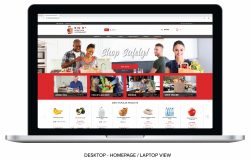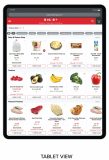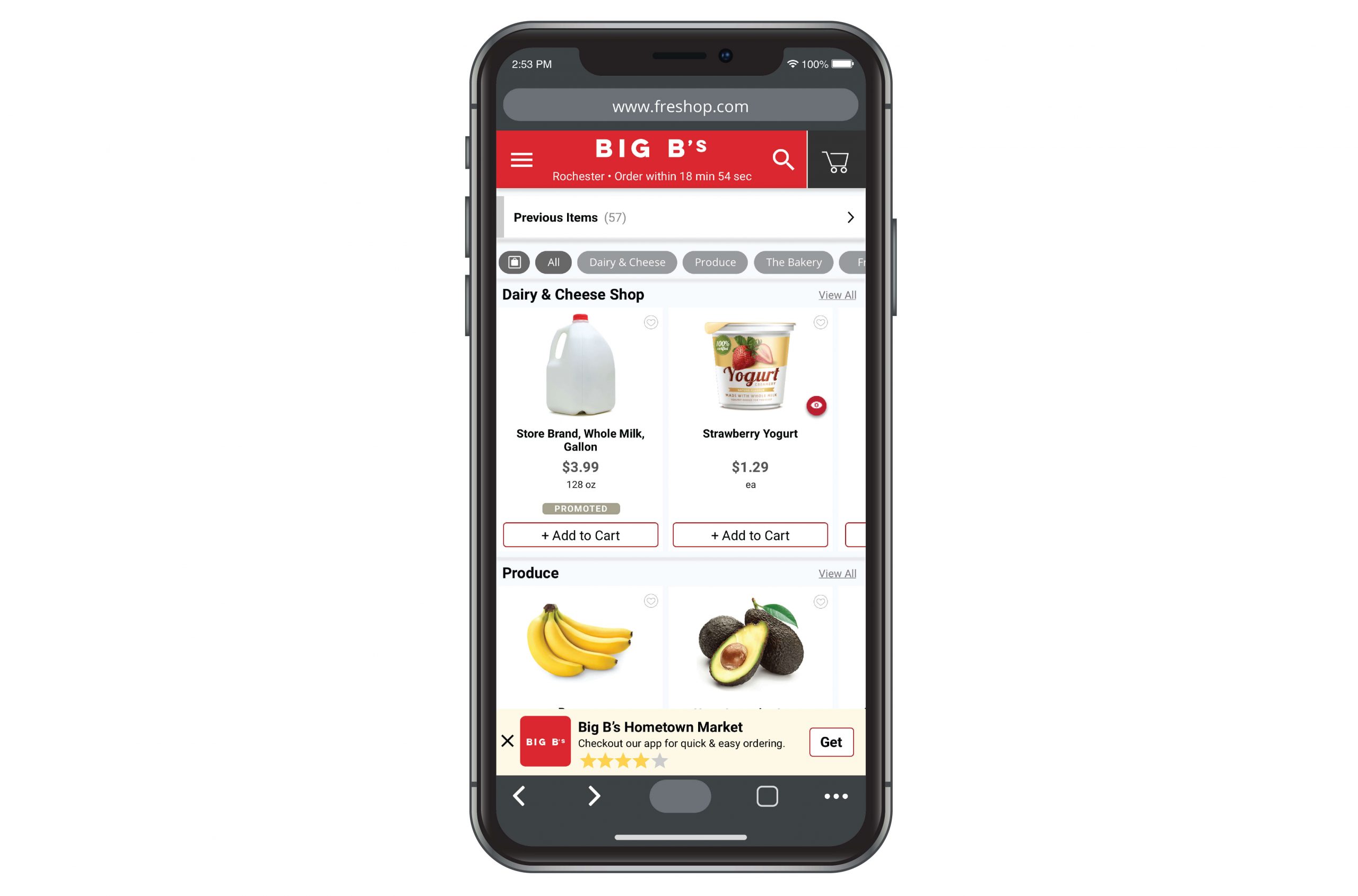Focus includes self-checkout, touchless store environments
by Mary Margaret Stewart, staff writer
Freshop is an e-commerce solution for grocery and retail. And as one might expect, CEO Brian Moyer said the platform has grown an incredible amount in 2020, acquiring thousands of new stores.
But why Freshop? According to Moyer, retail partners say the company “really knows grocery,” an understanding that has prepared the platform for the rapid flight to online grocery during the COVID-19 pandemic.

“The first thing is scale. We didn’t have any outages or hiccups. And that first week of March, we hit about 22 times volume that we had. None of our customers had to pay more or increase the number of servers – that was all handled by us,” Moyer said.
“We didn’t have any issues with being able to handle and scale up because we’re already prepared. We have single stores that do typically, $5,000 or $6,000 a day. And on a Cyber Monday the year before, they did $480,000. We already had the ability for a customer to scale up.
“To us, COVID-19 just looked like a really good Thanksgiving…it just reinforced our joy that we had committed so much to learning, living and breathing grocery.”
One of the specific features that Freshop rolled out in March was notify-when-ready. This allowed retailers to better communicate with customers about inventory.
“Most stores were immediately at a week backlog, where they couldn’t get orders out the door. Customers are placing an order today, but they were seeing 10 days from now when they could actually get their order.
“For most of our stores, they stopped saying, ‘I want this Tuesday at two o’clock.’ And so their primary way a person would place an order is ‘just put in your order, we’ll get it to you when we can…we’ll tell you when your order is ready.’”
Another way that Freshop helped its retail customers was through making COVID-specific help pages, whether those focused on notify-when-ready, employee procedures or available products.
“We tried to filter what was happening in the stores, distill it down and pump it back out to our stores…just in general on, what are you doing about [it]?
“We changed all of our websites that day, so they could put a COVID-19 notice at the top that said, ‘Hey, we limit one per on toilet paper and cleaning materials.’ Everybody looking at their website would see that immediately. We rolled out a whole series of features really quickly in response to that, and then we kept talking to our customers.”
And those conversations made it easier for retailers, in turn, to talk to customers. All everyone needed was information.
“It was a real give-and-take. The industry really got together and worked closely,” Moyer said. “None of our stores were resistant on sharing – they wrote best practices on…how do we communicate to our customers, how do we tell our employees if you’re symptomatic, don’t come in. We took that text and send it out to our other customers. And our stores were happy to share that.”
Rolling out SNAP compatibility
Another important aspect of Freshop’s work leading up to and throughout the pandemic is reflected in the recent full integration of SNAP on its platform.
“We started with the [SNAP] investment almost four years ago. When the pilot first came out, we started participating in that,” Moyer said. “We spent a lot of time going back and forth with the federal government while they were getting that done. We’ve been done for a long time with our actual coding of that and just waiting for them to roll out. When they finally started releasing it, we did.
“Well, COVID exploded and opened that up, so they quickly added 10 new states. It’s much more than 30 now. We’ve had it the whole time, and now it’s just waiting for each state to get live on there. I think we have 50-plus retailers that are in the pipeline…we keep launching new retailers on it.”
Moyer pointed to the importance of this expansion as it relates to the customer. And that importance has exploded during the pandemic.
“A lot of these SNAP customers are mobility challenged. It’s why they struggle to make money and where they need that help. Being able to place an order online, and use those benefits to be able to order their own groceries, gives them control over their own life.
“It’s been really important to open up e-commerce to a part of our country that hasn’t really had access to that right now. When you talk about the security of food, and what is eligible on the SNAP program, it’s really focused toward fresh and healthier types of products. There’s a limited selection of things that people can buy with their SNAP benefits.
“When you look at food security, what’s happening within our country right now with COVID-19 and unemployment and everything else, those SNAP benefits might be the primary way that people are getting food in their household.
“If a SNAP recipient or their family member is susceptible to COVID-19 or at-risk, not having to go into the store, not having to expose your family to that, is super important…to not have to go into the store and still be able to have control over their own destiny.”

Multi-channel shopping is new norm
With COVID’s unprecedented nature comes lasting impacts on the grocery industry. As Moyer noted, the need to provide a multi-channel shopping experience isn’t just a tactic that people are using but instead is “the way everyone shops.”
“In the context of most grocery stores, what they’re really talking about is communicating with their customers, especially the split between print and digital,” he explained. “Grocery has been slower to move to digital because of the high spend that they have on their weekly ad and the nervousness of going away from it, because they don’t really know what it translates to in sales. And it’s difficult to get rid of it.
“I think this is going to have a huge impact on the industry long-term. We had about 60 percent of our grocery stores during COVID-19 stop, or greatly limit, doing weekly ads because they couldn’t count on product availability. Putting that out was just going to get them in trouble. I think a lot of these stores obviously saw stupendous growth during COVID-19, without having a weekly ad that was paper.”
For stores that implemented real-time or perpetual inventory systems, their ability to communicate with customers was essential, Moyer said. They could update Freshop on what’s in-stock and what’s out-of-stock, reflecting these numbers by the hour for online ordering, which kept people from adding products to their cart only to later find out that they weren’t available.
As Moyer said, more information has been key through all of the fear and uncertainty. That ranges from product availability and COVID policies to hours of operation and senior shopping times – all of which are part of the multi-channel shopping experience.
“My IGA.com…they leveraged the Freshop platform to do what we call product-solution pages. If you go to their homepage, there’s links to booths of products that you can’t really physically do in the store. But online, it’s really easy,” he said.
“They had some brilliant ones at the end of the summer. And it showed you not only grilling stuff, but the stuff that goes around it. They did a pizza page. At the top, it had ‘here’s our frozen pizza, and here’s our appetizers that are pizza-related.’ But then they had the doughs, frozen or fresh, and then they had a whole row of pepperoni and then a whole bunch of cheeses. They included products that exist in different parts of the store, all the way down to the fresh produce department – ‘here’s items that you would normally put on a pizza.’
“In the store, it’s really difficult to bring those things together. What’s really becoming important for multi-channel shopping experiences is to bring together a food solution. Not too many people really need a recipe. What they really want is a collection of products that go together.
“If I want to buy breakfast for the week, show me the yogurts and granola and the blueberries and the raspberries and the bananas and the cereal and the milk. Put it all together and let me just pick all of those things. And those digital experiences, which are really a multi-channel-led thing, work super effectively for that.”
Looking to the future, Moyer said the next step for multi-channel shopping is to determine how to get people solutions once retailers have the information.
“That’s where stores are investing more – Facebook, geo-targeted advertising on Google or other platforms, tweeting out, posting to Pinterest – all of those kinds of things to drive people in,” he said.
“First, they’ve got to have a really good platform. We think that Freshop really is, by far, the market leader for that. And then as they invest in those digital experiences, they can reduce or eliminate their print spend. That’s where that multi-channel has really been exciting for the independent.
“They can spend dollars more effectively, they can reduce the ambiguous spend with their online spend, they can see a lot more. How many people are looking at my website? How many pages do they look at? If I’ve got a four-page ad, what percentage of people made it to the fourth page?
“All of that kind of stuff has been a real boom for the grocery industry – that’s also starting to drive more dollars in that multi-channel shopping experience.”
And for the future of Freshop, Moyer said the company has been advancing its quick-serve meal solutions.
“A lot of stores have those features, but they’re more where you walk up to the deli and you ask for things. It’s really important now for people to be able to do that more touchless and be able to place that order ahead of time.
“We’re continually adding a lot of features for stores to be able to roll out the quick-serve restaurant-type features to their customers, even if they’re being prepared in their traditional deli and they don’t have a restaurant, per se.
Part of this quick-serve option is Freshop helping the retailer with technology, such as printers for the deli department.
“Most people aren’t looking at a tablet all day. They just need an order to print off that they can execute and get it ready. We’re doing a lot of features that are more in the store.”
Of course, part of touchless grocery shopping is providing that experience, something in which Freshop also has focused its efforts.
“An expansion of our Scan Plus Go – the ability for a customer to self-checkout has become really important. We’re rolling that out here now to store,” Moyer said.
“And then Lane Buster. Lane Buster is where a store can use our personal shopper app [for checkout]. And so, we’re doing a lot more things that are close around the point-of-sale system to help stores really execute touchless environments and scale up their ability to deal with customers without having to compress them into lines.
“It’s one of the biggest challenges during COVID as the stores are busier, but you can’t have a line pushing back into a one-way aisle where people can’t social distance…that has extended itself again into accelerating things we were already doing for stores.
“Now it’s like, ‘I need a way to get customers out the door quicker and be able to get a payment without them going through a lane.’”
Moyer added that while these features have been important amidst the pandemic, Freshop is seeing more stores viewing touchless checkout and self-checkout as a better way to work.
“Instead of having eight lanes, and we keep four closed all the time, let’s convert those four selling spaces…let’s get some more square footage that we can use to sell,” he said.
“It’s been interesting to see how people have modified their business for COVID-19 and how they adapted their utilization of our platform, but also how they’re looking to the future and saying, ‘Hey, we used that for this. Freshop, can you add these three things on there that will let us use this in perpetuity?’”
To learn more about Rochester, New York-based Freshop, click here.

